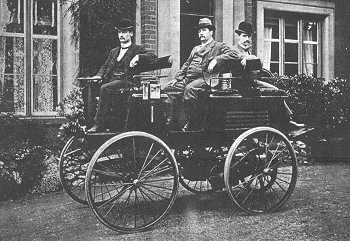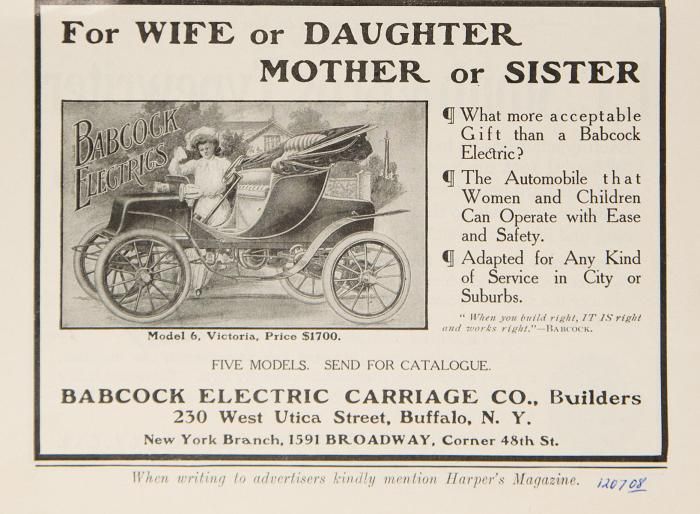
Menu
Menu

Electric Cars are becoming quite common these days. They can be spotted in both urban and rural setting, and come in various models and types. There are 2 wheeler EVs like bikes, mopeds, and scooters, 3 wheeler EVs like e-rickshaws, autos, and usual 4 wheeler EV sedans, SUVs, an luxury cars. Apart from them, buses, trams, rovers, and various other vehicles can also be called EVs simply because they run on electricity. Many of these EVs sport a modern look and come loaded with high tech features giving them the contemporary vibe of a 21st century product. But the history of EVs goes quite a long way back in time and is full of surprising twists and turns. Let’s travel back in time to unwind the long story of EVs and see how they have evolved to meet the demands of modern society.

The crude version of electric vehicle made its first appearance somewhere in the 1830s. At this time the chief mode of travel was horse drawn carriages and buggies which required an immense amount of effort for maintenance and functioning. During this period, scientist and inventors from region like Hungary, Netherlands, and United States were developing the concept of electric motor based vehicles, and one such inventor – Robert Anderson ended up displaying his version of the electric car at an Industry conference in 1935.
Anderson’s version of the electric car was more of a carriage powered by disposable battery and ran on crude oil to turn the wheels. During this time, inventors from all across the globe like Anyos Jedlik, Thomas Davenport and Sibrandus Stratingh invented different models of the electric vehicles that developed integral components of the car. However, many of these ‘EVs’ were more of a parlour trick as they did not sport any rechargeable batteries.
The dawn of electric cars occurred at a moment when battery chemistry had not advanced to it’s mature state. Thus, even though the carriages were powered by batteries and electric motor, they could not be recharged leading to a lack of adoption of the EVs as the chief mode of transport. However, by the 1860s, advancement in understanding of battery chemistry and innovation led to the possibilities of rechargeable batteries. This pumped the growth of the electric vehicle as a viable means of transport, and by 1890, the first practical model of the electric car was designed by William Morris from Des Moines, Iowa who presented the EV at a trade fair in #America.
The upgraded version of the initial electric carriage proved well, especially with the American audiences. Perhaps, the ease of use, silent operation, luxury, and development of roads prompted the general public to adopt this new mode of traveling. By the 1900s, American roads were teeming with electric carriages, which had replaced the traditional horse drawn buggies, and some startups had gone so far ahead as to provide a completely electric cab service. They set up small fleets in cities like Boston and Baltimore, and the eternal problem of charging was addressed by converting an ice arena into a battery swapping station where cabs could replace their depleted batteries with fully charged battery sets. So, if you think that the idea of a battery swapping station is contemporary, just remember – history repeats itself.
The opening of the 20th century was a bit dramatic for the story of electric vehicles. In the early years, the EVs gained widespread popularity often becoming a symbol of urban opulence, comfort, and luxury. They fared much better than the horse-drawn carriages and were definitely superior to the clunky gasoline powered vehicles that had to be operated with a hand crank. Sleek, silent, and easy to operate – the electric vehicles became a staple presence in the urban lifestyle, and were often advertised as products suitable even for women (back then, automobiles were perceived to be chiefly masculine interest). According to a story, it’s told that electric cars became so popular amongst women that Henry Ford ended up gifting one to his wife Clara . Unfortunately and ironically, Henry Ford himself became one of the key reasons behind the decline in the growth of the EV culture.

By the 1910s, the electric starter had been invented bringing the era of hand crank to an end, thereby making it easier to operate the gasoline powered vehicles. During this time, Ford’s Model-T gained unparalleled popularity prompted by the mass production of the vehicle and falling prices. In 1908, the first Model-T cost $850, which was half the price of electric cars, and by 1923, the price had fallen to $350. Economic considerations like this and the electric starter (invented by Charles Kettering for 1912 Cadillac) proved to be the bane to the EV culture.
Ofcourse, the growth of gasoline powered vehicles and the decline of electric vehicles cannot be attributed to just a single cause as there were many interrelated and complex factors involved such as development of World-War 1, rising fuel prices, and construction of better roads. The electric cars did survive for a brief while, but ultimately, they began to fade out of existence as the easy to operate, cheaper, and mass produced gasoline powered vehicles dominated the roads.
The long hibernation period for the production of electric vehicles stretched throughout the period of two world wars and gasoline powered vehicles marked their dominance everywhere in the world resulting in the establishment of gas stations all across roads, cities, and towns. However, this golden period for the gas based cars encountered its first challenge in 1973 when OPEC imposed an oil embargo resulting in the overnight increment of oil price by $12.
The recent world war, economic instability, and environmental destruction had already begun to put a strain on the fuel prices, but the oil embargo of 1973 dealt the final blow, opening the doors for electric vehicles once again. This was the decade when NASA managed to put a rover on the moon and since there are no gas stations on the moon, this rover was powered by electricity, technically making it an electric vehicle. The famous Citicar, developed by Sebring-Vanguard, was also launched in this decade, and prior to Tesla, Citicar was the face of EV.
The oil embargo of 1973 paved the way for the resurgence of electric vehicles, but their journey was not smooth and they faced many ups and downs. Between the 1970s-90s, many automobile makers had a fling with electric cars, often converting their traditional ICE version electric, but the electric models failed to make significant impact at the market. This era witnessed the birth of GM’s EV1 and Electrovette, and many small electric vehicles were used throughout the world for small scale service like cabs and deliveries at urban hotspots that demanded cost effective and short range services. Milk floats were pretty famous in Britain during the 80s and likewise cab services benefited from electric vehicles. However, a complete and proper revival of electric vehicles didn’t occur until after the 1990s.
The gasoline powered vehicles had enjoyed their dominance for a long time, but environmental concerns like carbon emissions & air pollution coupled with rising fuel prices began to put a strain on their reign. The 90s witnessed the development of many regulatory policies that aimed to reduce the detrimental impact of gasoline power vehicles on the climate. One such policy was the 1996 Zero Emission Vehicle mandate whose goal was to maintain tailpipe emissions standards by manufacturing ‘zero emission vehicles.’
Thus, in the 90s, many car manufacturers experimented with the development of electric cars by converting the ICE models into their electric variants such as the Toyota RAV4 EV. The period also witnessed the development and launch of new models like the GM’s EV1, but it wasn’t till 1996 that the growth of EV really took off with the release of Toyota’s Prius.
The Prius was the first mass produced hybrid vehicle from Toyota and it gained a cult following among common public & celebrities for its eco-friendly design and functionality. From here onwards, EVs began to reappear on the scene with more and more automobile makers pledging to achieve the mandate of creating modern vehicles with low carbon emissions.
Prius’ launch and success opened the door for the revival of electric vehicles. The age-old fascination with the electric motor and battery, that had died off in the 20th century, found a fresh momentum at the birth of the 21st century. In 2006, thanks to the favorable innovative environment established in Silicon Valley, Tesla launched the first version of its completely electric luxury car called The Roadster.
The Roadster met with positive reaction and the surprisingly high sales of the sports-luxury vehicle hinted at the direction that EVs would take in the future. By the 2010s, battery chemistry and technology had advanced to such a state that their prices fell by almost 50% sparking an EV revolution in the automobile industry. Thus, the 2nd decade of the 21st century witnessed the launch of countless electric vehicles and government policies began to favor and push for the mass production of these eco-friendly vehicles. Automobile makers started to join the EV race and by the 2020s, almost everyone had launched a model or two fully reviving the era of electric vehicles.
Today, electric vehicles play a crucial role in mitigating climate change. Their low tailpipe emissions, non dependence on fossil fuels, and superior technology make them the ideal choice for the modern world struggling with developmental challenges and climate crisis in the automobile sector. In the future, EVs are destined to play a major role in initiating a paradigm shift that can transform the entire automobile industry making it more sustainable and environment friendly.
As with all innovative technology, electric vehicles also have to deal with their fair share of problems such as user apprehension related to range anxiety, lack of charging infrastructure, and high up-front cost of the electric models. However, manufactures, companies, and climate tech startups continue to develop innovative solutions promising to transform the automobile landscape that’s more conducive to the deployment of electric vehicles. The true story of EVs will be clear as time passes, but their continued growth and sales indicate that the future is bright.






© 2024 Massive Mobility Private Limited. All rights Reserved